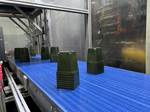Global Film Processor Sets Sights on U.S. Growth
With six plants in four continents, Flex Films’ strategy is to offer highly customized, ‘holistic’ solutions in BOPET, BOPP, and specialized films and coatings.
The global film manufacturing arm of Uflex Ltd., India’s largest multinational flexible packaging company, Flex Films has set up shop in North America with an eye toward expansion. With the opening of a greenfield plant in Elizabethtown, Ken. In 2013, the firm has state-of-the-art film manufacturing facilities in Asia, Europe, North America and Africa with cumulative production capacity in excess of 337,000 metric tons/yr.
Flex Films has been selling in the U.S. since the mid-1990s, first out of Charlotte, then Houston. It’s 180,000 ft² plant in Kentucky houses an 8.7-meter line producing biaxially oriented PET (BOPET), as well as systems for metallizing and coating. The facility can room for four more lines, says Anantshree Chaturverdi, Flex Films’ vice chairman and CEO. Uflex was founded in 1984 by Chaturverdi’s dad, who he said is considered “the father of the flexible packaging industry in India.”
Globally, Flex Films has production capacity not only for BOPET, but for BOPP and cast PP, in addition to metallized and coated films, and a line of specialty films. Its primary markets are food and pharmaceutical packaging, and films for solar and construction applications. It has a line that apply a thin and highly transparent coating of aluminum oxide on films that gives the materials extremely high moisture and gas barrier properties rivaling those of aluminium foils and metalized films. Flex Films says it’s the only truly high-barrier flexible packaging material available that is transparent and allows the packaged product to be clearly visible.
The opening of the Kentucky plant is illustrative of Flex Film’s strategy to be offer customized solutions. States Chaturvedi, “You can’t innovate in one part of the world and believe that the solution will apply globally. Our approach to working with customers is to be close—even local—and holistic.”
Related Content
-
How to Effectively Reduce Costs with Smart Auxiliaries Technology
As drying, blending and conveying technologies grow more sophisticated, they offer processors great opportunities to reduce cost through better energy efficiency, smaller equipment footprints, reduced scrap and quicker changeovers. Increased throughput and better utilization of primary processing equipment and manpower are the results.
-
Green’s the Theme in Extrusion/Compounding
The drive toward circular economy is requiring processors to make more use of PCR. Machine builders at K—across all extrusion processes—will be highlighting innovations to help them do just that.
-
DeDuster Systems Cleans Up rPET Sheet
rPlanet cut its gel count drastically—allowing it to sell more sheet at prime prices—after installing a DeDuster system.



